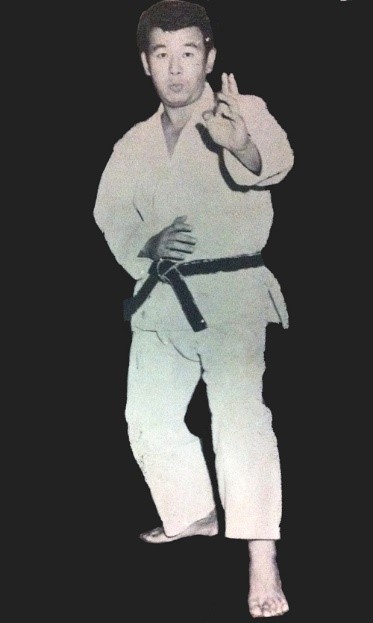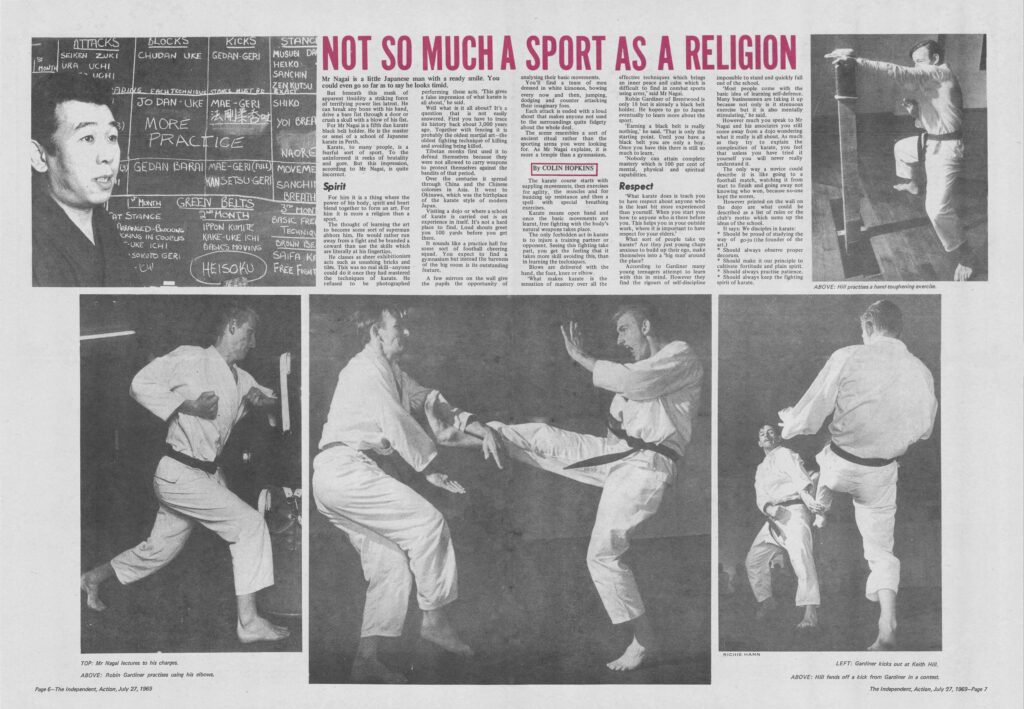
The Karate-do Goju-Kai Academy of Japan was established in Western Australia in 1967 under the instruction of Yasunobu Nagai. Nagai Sensei, a 5th Dan instructor from the Goju-Kai Hombu Dojo in Tokyo, set a high standard of technical excellence gained through intense physical training. Hanshi Mackie was one of Nagai Sensei’s first students and became chief instructor of the Academy on Nagai Sensei’s departure in 1970.

Independent Newspaper Article – July 27th 1969
The following newspaper article is from the Independent Newspaper dated 27th July 1969 and profiles Nagai Sensei, the origins of Karate and training back in the day. A full readable text excerpt is supplied underneath the scan of the article.

NOT SO MUCH SPORT AS A RELIGION (by Colin Hopkins)
Mr. Nagai is a little Japanese man with a ready smile. You could even go so far as to say he looks timid.
But beneath this mask of apparent timidity, a striking force of terrifying power lies latent. He can break any bone with his hand, drive a bare fist through a door or crush a skull with a blow of his fist.
For Mr. Nagai is a fifth dan karate black belt holder. He is the master or sensei of a school of Japanese karate in Perth.
Karate, to many people, is a fearful sort of sport. To the uninformed it reeks of brutality and gore. But this impression, according to Mr. Nagai, is quite incorrect.
Spirit
For him it is a thing (Karate) where the power of his body, spirit and heart blend together to form an art. For him it is more a religion than a sport.
The thought of learning the art to become some sort of superman abhors him. He would rather run away from a fight, and be branded a coward, than use the skills which are literally at his fingertips, he classes as sheer exhibitionism – acts such as smashing bricks and tiles, this was no real skill. Anyone could do it once they had mastered the techniques of karate. He refused to be photographed performing these acts. ‘This gives a false impression of what karate is all about,’ he said.
Well, what is it all about? It’s a question that is not easily answered. First you have to trace its history back about 3,000 years ago. Together with fencing, it is probably the oldest martial art—the oldest fighting technique of killing and avoiding being killed.
Tibetan monks first used it to defend themselves, because they were not allowed to carry weapons to protect themselves against the bandits of that period.
Over the centuries it spread through China and the Chinese colonies in Asia. It went to Okinawa, which was the birthplace of the karate style of modern Japan.
Visiting a dojo, or where a school of karate is carried out, is an experience in itself. It’s not a hard place to find. Loud shouts greet you 100 yards before you get there.
It sounds like a practice hall for some sort of football cheering squad. You expect to find a gymnasium, but instead the bareness of the big room is its outstanding feature.
A few mirrors on the wall give the pupils the opportunity of analyzing their basic movements.
You’ll find a team of men dressed in white uniforms (Gi), bowing every now and then, jumping, dodging and counter attacking their imaginary foes.
Each attack is ended with a loud shout, that makes anyone not used to the surroundings, quite fidgety about the whole deal.
The scene resembles a sort of ancient ritual rather than the sporting arena you were looking for. As Mr. Nagai explains, it is more a temple than a gymnasium.
The karate course starts with suppling movements, then exercises for agility, exercising the muscles and for building up resistance, and then a spell with special breathing exercises.
Karate means open hand (empty hand) and once the basic movements are learnt, free fighting with the body’s natural weapons takes place.
The only forbidden act in karate is to injure a training partner or opponent. Seeing this fighting take
place, you get the feeling that it takes more skill avoiding this, than in learning the techniques.
Blows are delivered with the hand, the foot, knee or elbow.
‘What makes karate, is the sensation of mastery over all the effective techniques which brings an inner peace and calm, which is difficult to find in combat sports using arms,’ said Mr. Nagai.
Robin Gardiner of Brentwood is only 18 but is already a black belt holder. He hopes to go to Japan eventually to learn more about the sport.
‘Earning a black belt is really nothing,’ he said, ‘That is only the starting point. Until you have a black belt you are only a boy. Once you have this there is still so much to learn.
‘Nobody can attain complete mastery which is 100 per cent of mental, physical and spiritual capabilities.
Respect
‘What karate does, is teach you to have respect fort anyone who is the least bit more experienced than yourself. When you start, you bow to anyone who is there before you. This helps you in your outside work, where it is important to have respect for your elders.’
What sort of people take up karate? Are they just young chaps anxious to build up their ego, make themselves into a ‘big man’ around the place?
According to Gardiner many young teenagers attempt to learn with this in mind. However, they find the rigors of self-discipline impossible to stand and quickly fall out of the school.
‘Most people come with the basic idea of learning self-defence. Many businessmen are taking it up because, not only is it strenuous exercise, but it is also mentally stimulating,’ he said.
However, when you speak to Mr. Nagai and his associates, you still come away from the dojo wondering what it is really all about.
As much as they try to explain the complexities of karate, you feel that unless you have tried it yourself, you will never really understand it.
The only way a novice could describe it, is like going to a football match, watching it from start to finish and going away not knowing who won, because no-one kept the scores.
Printed on the wall of the dojo are what could be described as a list of rules or the club’s motto – which sums up the ideas of the school.
It says: We disciples in karate:
* Should be proud of studying the way of go-ju (the ‘way’ of the art of Goju.)
* Should always observe proper decorum.
* Should make it our principle to cultivate fortitude and plain spirit.
* Should always practice patience.
* Should always keep the fighting spirit of karate.
Picture captions:
ABOVE: Hill practices a hand-toughening exercise.
TOP: Mr. Nagai lectures to his charges.
ABOVE: Robin Gardiner practices using his elbows.
Page 6—The Independent, Action, July 27, 1969
LEFT: Gardiner kicks out at Keith Hill.
ABOVE: Hill fends off a kick from Gardiner in a contest.
The Independent, Action, July 27, 1969 – Page 7
